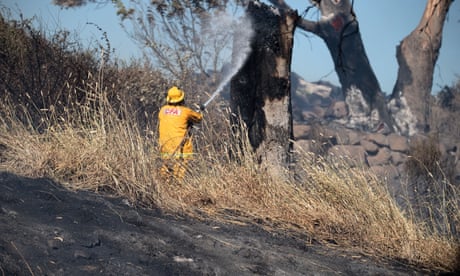- by foxnews
- 17 Mar 2025
Australia faces unprecedented grassfires next summer ‘supercharged’ by global heating
Australia faces unprecedented grassfires next summer ‘supercharged’ by global heating
- by theguardian
- 22 Feb 2023
- in news

Australia should prepare for grassfires on a scale not experienced before, with new analysis warning spring and summer 2023-24 could see widespread fire risk "supercharged" by the climate crisis.
The report, by the Climate Council and Emergency Leaders for Climate Action (ELCA), said there is also an increased risk of more grassfires breaking out in New South Wales, Queensland, Victoria, South Australia and Western Australia during the current fire season up to April.
Firefighters have battled multiple grassfires in recent weeks including in regional Queensland and NSW.
The Climate Council's report noted fuel loads in some inland areas had a normal range of between 0.5 and 1.5 tonnes a hectare but were now between 4.5 and 6 tonnes a hectare as a result of heavy rains.
Heatwaves and dry conditions were now turning those areas yellow and brown, creating what the report described as "powder keg" conditions for future fires.
The founder of ECLA and a former commissioner of Fire and Rescue NSW, Greg Mullins, said the summer of 2023-24 would almost certainly see a return to normal or above normal fire conditions.
He said all levels of government "need to understand the escalating risk of devastating fires and ramp up preparedness now".
Grassfires, while generally less intense than forest fires, can be just as dangerous. They can move up to three times faster than a bushfire and can catch people out with their speed.
The climate crisis has worsened since then and intensified extreme weather, leading to concerns that if extensive grassfires broke out now they could be more destructive and deadly.
"Firefighters fear that grass fires occurring in hot, dry and windy conditions worsened by climate change could unfold on a scale never before experienced, potentially overwhelming emergency services at times, and placing communities at great risk," Mullins said.
David Karoly, a climate scientist and Climate Council councillor, said the current hot conditions in many parts of Australia had led to rapid drying and curing of grasses since the start of summer.
"We've got now already very high risks of grassfires and they have already occurred in parts of NSW, SA, Victoria and WA," he said.
Karoly said that risk would move to northern Australia through the winter dry season and then back to the southern states from spring.
"This is again because of climate change-elevated temperatures and an elevated rate of drying and curing of the fuels," he said.
The Climate Council and ELCA make several recommendations, including increased funding for emergency services and land management agencies to respond to disasters.
The report has called on the federal government to develop a single, integrated climate adaptation and disaster resilience strategy and for more funding for education and resilience projects in communities.
It said emergency management agencies and state and local governments need permanent - rather than ad hoc - arrangements in place for long-term disaster recovery efforts.
- by foxnews
- descember 09, 2016
Rare artifacts representing America's 250th birthday will be featured in major exhibition
Rare artifacts will be featured in the "Give Me Liberty" exhibit at the Virginia Museum of History & Culture in Richmond to commemorate America's upcoming 250th anniversary.
read more


